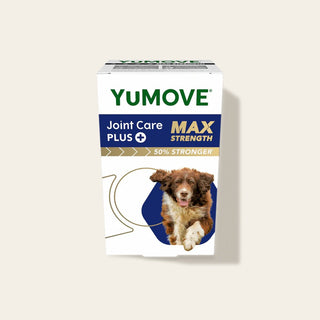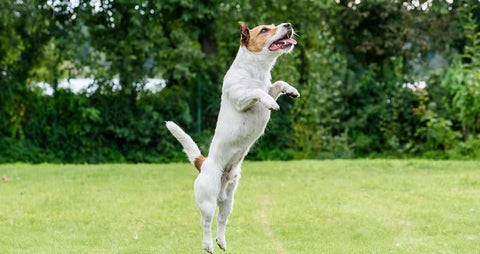

Dog joint stiffness: demystifying the myths
At YuMOVE, we’re passionate about helping dogs with joint stiffness. If you’re anything like us, you’ve probably spent countless hours searching for different remedies. From canine acupuncture to abandoning walkies, we’ve heard almost every single ‘wonder’ treatment out there. But what’s the truth behind these strategies?
Before we get into it, it’s important to note that while there isn't a ‘cure’ for joint stiffness in dogs, there are many ways to help manage it and help keep your dog active. In this guide, we take a closer look at some common remedies for dog joint stiffness and reveal which ones are most effective. Let’s dive in:
What is joint stiffness in dogs?
Joint stiffness can affect dogs at any age and size, although it’s more common in older and larger dogs. It happens when the cartilage on the surfaces of your dog’s joints gets thinner, leading to less cushioning and more friction between the bones. Over time, changes and deterioration can often be seen in the bones too.
What are the signs of stiffness in dogs?
Spotting the signs of stiffness can be tricky, but here are a few things to look out for:
- Stiff movement or reluctance to move as much
- Difficulty jumping up or climbing the stairs
- Weight gain
- Behavioural changes, like irritability
- Whimpering after being touched
If your dog shows any of these signs, it’s a good idea to consult your vet to rule out any other conditions.
“Good mobility plays a big role in helping our pets lead their richest and happiest lives – which is why proper joint support is so important. Remember, not all joint care remedies are proven to be effective, or even safe. If in doubt, we always recommend speaking to your vet before trying a new joint care supplement or therapy, or if you have noticed any changes to your pet's mobility.” – Dr Charlotte Rice, Senior Veterinary Technical Manager at Lintbells
Myth 1: Exercise is a complete no-no

Many dog owners believe that any form of exercise is out of the question for a pet with stiff joints. But the reality is that moderate, gentle exercise is crucial for helping to ease your dog’s stiffness. Regular exercise also helps maintain a healthy weight and keeps your dog’s joints moving smoothly.
The optimal amount of activity varies depending on each individual dog. A short stroll two to three times a day, as opposed to one long walk, is a good starting guideline. However, be careful not to overdo it. Most dogs love walkies, and the exercise releases endorphins, so your pup may feel more comfortable and want to do more than their body allows.
Of course, there can be other times when strict rest is important. If you are unsure about the best exercise regime for your pet, be sure to check in with your vet.
Myth 2: Joint stiffness is always obvious
While you’ll certainly be able to tell when a dog is dealing with severe joint stiffness, the truth of the matter is that joint stiffness exists on a continuum. Many dogs deal with some degree of joint stiffness every day that can undermine their wellbeing – but go without extra support because the signs are subtle.
Be on the lookout for any changes in your dog’s normal behaviour and physical activity levels, and speak to your vet if you have any concerns. These signs can be challenging to identify and your vet can help you!
Myth 3: Acupuncture is useless

Acupuncture for dogs is often dismissed as an ineffective alternative treatment, but research suggests that it can be beneficial in different therapeutic contexts.
During an acupuncture session, your dog’s nerves will be stimulated with needles to help boost blood flow and relax muscles. With regular treatments, acupuncture may help promote mobility in your dog. This ancient form of Chinese medicine has been practiced in the West since the 1950s and there’s growing research to support its efficacy and safety.
However, studies often have limitations and there isn’t a consensus in the veterinary world on its effectiveness. In summary, acupuncture should be safe, and there’s evidence to support its use as part of a combined stiffness management program. But we wouldn’t recommend it as a sole treatment.
Natural remedies to try at home
Supplements
Our Joint Supplements for Dogs range features a triple-action formula that soothes stiffness, supports joint structures and aids mobility. We rigorously test our ingredients to ensure that your pet gets nothing but the best in every batch.
Better yet, YuMOVE Joint Care's trusted formula delivers visible results in just 6 weeks, making it a great supplemental option for supporting your pet’s mobility, day by day.
Weight management
Maintaining a healthy weight is perhaps the most important part of supporting your dog’s overall wellbeing. A lean body weight can decrease the amount of stress on the joints and improve overall wellbeing.
Home adaptations
A few modifications in your home can make all the difference to your dog’s joint health. Here are some of our favourite tips:
- Put non-slip mats on floors like hardwood, tiles and laminate to prevent your pup from stumbling.
- Buy a comfy, ergonomic bed that’s the right size for your dog.
- Use elevated food bowls to prevent straining.
- Add a stairgate or ramp to reduce your dog’s use of the stairs and make them easier to use.
For great joint support supplements for every dog, shop our Dog Joint Supplements today!



